A voice call API enables businesses to automate customer calls and manage them programmatically with little to no human intervention.
Programmers can easily build scalable, high-quality speech applications in the cloud or incorporate voice functionality into already-existing applications and services. This technology’s ability to design a personalized voice solution that caters to your particular business requirements makes it so useful.
Benefits of Using Voice Calling API
The best scenario in which such APIs can be really beneficial is customer service and support management. With the help of these APIs, you can send an automated voice message when the support line is busy so that the customers don’t have to wait for eternity!
Another area in which it’s useful is marketing and communications. It helps businesses to promote new products to their customers.
Businesses can perform all these things without becoming an expert in telecoms infrastructure. They can direct the resources toward developing voice solutions that improve the client experience if they can focus on their primary business objectives.
Here are some business applications in which voice-calling APIs can be really beneficial:
- Sales & Marketing
- Customer Service
- Order Updates
- Sending Reminders
- Conducting Surveys
Key Features of a Voice API
#1. Interactive Voice Response
It makes it easier for callers to reach their desired solution by providing interactive menus and options during a voice call. By doing so, most customers can self-service and find a solution; if not, they can be redirected to a live human support agent.
#2. Call Recording
It gives businesses more control over gathering customer insights and making informed decisions based on that. Also, it is useful for quality assurance and compliance purposes. However, customers should know beforehand that the call is being recorded.
#3. Text to Speech & Vice-Versa
Speech-To-Text and Text-To-Speech are important in voice-calling APIs for programmable call responses and customer interaction.
#4. Call Routing & Scheduling
This feature is crucial in customer service centers where multiple customers access the same line. The API should proficiently redirect each request to its respective department based on some instructions.
#5. Call Transfer
The API should be able to transfer calls from automated responses to a live human agent if needed and between multiple departments as well.
These key features should be present in a decent-quality voice call API. Next, let’s look at some voice-calling APIs and the features they offer.
Agora
Agora is a real-time communications platform that provides products and extensions such as video calling, voice calling, broadcast streaming, and analytics. For voice calling, it provides an SDK, i.e., a software development kit that allows developers to easily integrate Agora voice API with their applications.

The voice calling SDK includes features such as AI noise suppression and 3D spatial audio to create an immersive experience. Also, you can use the real-time transcription feature for live audio captions. The SDK is cross-platform, supporting Windows, MacOS, Android, Web, Flutter, Electron, and many other platforms.
The best part is that it offers pay as you go pricing plan, and the first 10,000 minutes are free every month.
Sendbird

Sendbird is also a communications platform offering a variety of SDKs and APIs to facilitate video and voice calling as well as live streaming. It provides SDKs for iOS, Android, Javascript, Unity, and React Native. While these SDKs take care of the client side, the platform API takes care of the server-side monitoring of the call functionality.
It offers a dashboard for call analytics features such as call logs, call metadata, admin calls, automated billing, etc. Sendbird is HIPAA compliant, ensuring security requirements for healthcare organizations. The pricing is based on number of minutes per user.
Twilio
Software developers can include voice calling capability into their applications and services using the APIs and services provided by Twilio Voice, a cloud communication platform. It helps build an engaging voice experience that you can quickly scale and modify with various customization options and resources.

With the help of voice intelligence, businesses can turn voice calls into actionable data insights with machine learning. Also, they can analyze and activate call recordings to create personalized voice experiences that drive revenue.
Twilio voice offers features such as:
- Call tracking
- Embedded calling
- Masked calling
- Global conferencing
- Interactive Voice Response
Fortunately, Twilio offers pay-as-you-go pricing plans so you don’t get locked into big contracts.
Dolby
Dolby also provides a communications API for voice and video calling, and by using it, you can leverage the ability to create crystal-clear voice chat and call for your browser, mobile, and PC apps.

It provides features such as a voice activity detector, automatic gain control, and dynamic audio leveling. All of this detects speech, removes background noise, keeps unwanted sounds out, and maintains consistent levels between clients.
It is GDPR, HIPAA, and SOC-2 compliant. Dolby offers a free and pay-as-you-go plan for its voice-calling API.
Plivo
Plivo is a communications platform with an API platform for messaging, voice calls, and solutions for sales and support teams. Its voice-calling API lets you integrate voice calling within your applications and programmatically make, receive, and control calls worldwide.
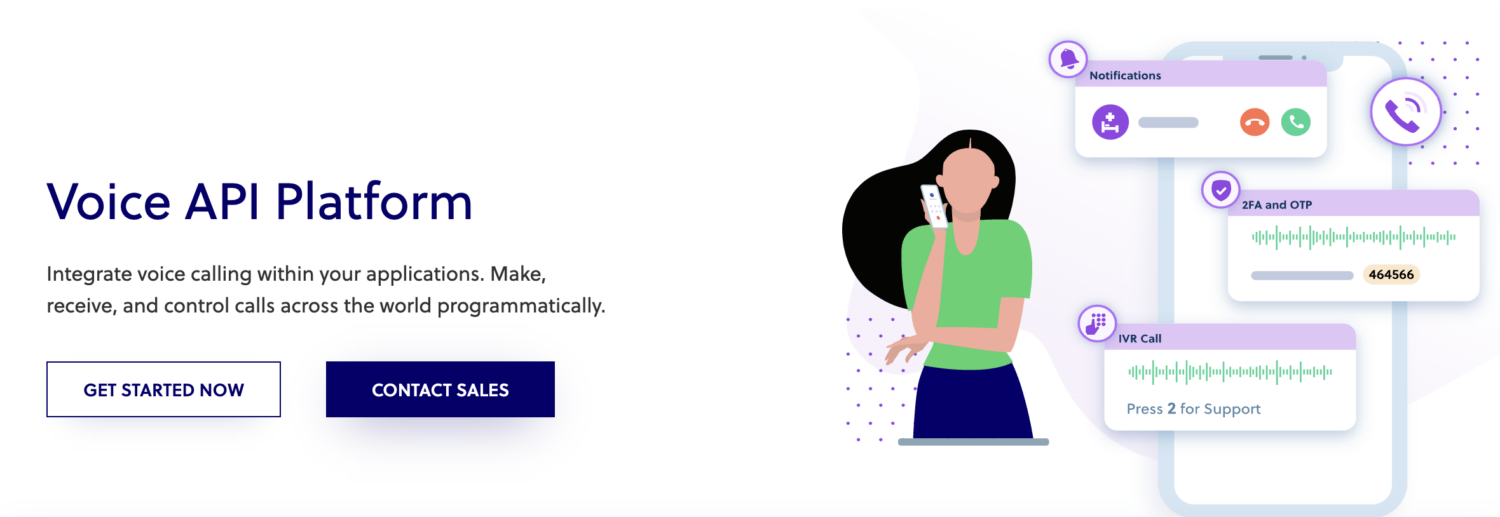
For web applications, plivo provides a browser SDK, and for native mobile apps, it provides a separate mobile SDK. Features include:
- Voicemail Transcription
- Text to Speech
- Call Feedback API
- Dynamic Caller ID
Same as other platforms, it provides a pay-as-you-go pricing model.
SignalWire
SignalWire is a cloud communications platform providing various services, including voice calling, video conferencing, SMS messaging, etc. It promises unmatched voice quality with Hi-Fi Voice technology, no more crackling voices or users sounding like they are overseas.

The novice features it offers to send voice streams to any URL from a call in real-time. This is helpful when monitoring customer support calls. The pricing plans for SignalWire are much more complex.
Enablex
Enablex’s easy-to-implement Voice APIs and SDKs enable you to market faster and enjoy crystal-clear call quality. You can make and receive calls from anyone with an internet connection or a phone number. Also, you can embed Voice-over-IP (VoIP), PSTN, and SIP calling directly into your app or browser using your preferred programming language.
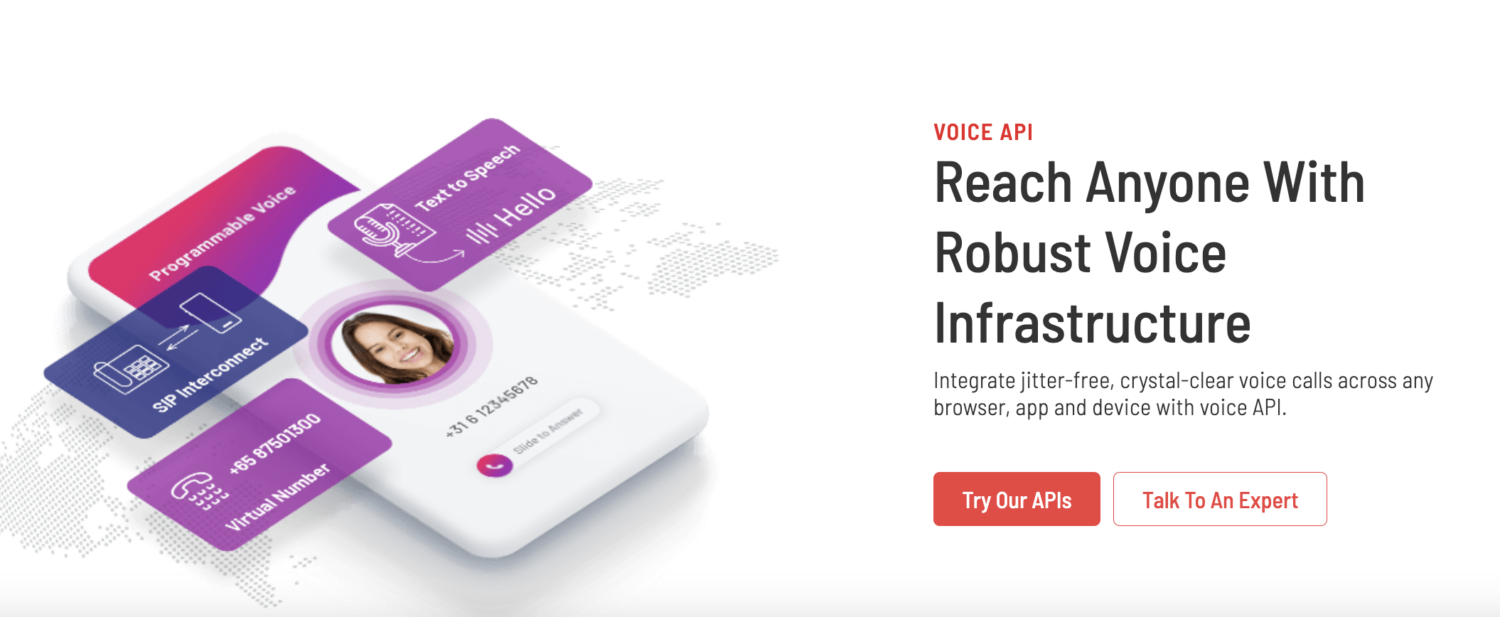
Features include:
- Group voice call
- Virtual numbers
- Automated voice messages
- SIP Interconnect
Enablex offers flexible as well as pay-as-you-go pricing plans.
RingCentral
With the help of RingCentral Voice APIs, you can programmatically customize your apps so that they may make and receive calls, handle voicemails, and trigger webhooks. RingCentral is a communications platform offering a variety of APIs for various communication channels.

With RingCentral’s voice calling API, you can route and manage calls dynamically in real-time, extend or customize your existing apps to include voice capabilities and integrate AI systems. It offers free unlimited calling within the US and Canada.
Telesign
Telesign is a communications platform as a service that provides secure communication and identity verification solutions. With its voice API, you can build secure and reliable A2P, P2A, and P2P voice applications using web and mobile platforms.

Some of the features provided by Telesign’s voice API are:
- Auto speech recognition
- Monitor traffic
- Speech-To-Text
- Interactive Voice Response
You can acquire and implement phone numbers across 120+ countries and also reformat phone numbers, as well as record calls. You can contact Telesign’s sales team to get information on pricing plans.
Vonage
Vonage is a global communications platform providing communication services and specializing in conversational commerce. You can integrate third-party artificial intelligence bots using WebSockets, enable self-service in more than 120 languages using automated speech recognition, and also combine voice and social media channels for increased customer interactions.

Features:
- WebRTC Support
- WebSockets
- Audio streaming
- Speech Synthesis Markup Language
- Globally Distributed Call Controls
- Fraud Defender
It offers pay-per-use pricing plans.
MirrorFly
MirrorFly voice calling API lets you connect, manage, & route calls across any device and get unlimited audio calling. It lets businesses build voice applications with its programmable voice API. You can make and receive calls from browsers, apps, and web applications to cater to your business needs.
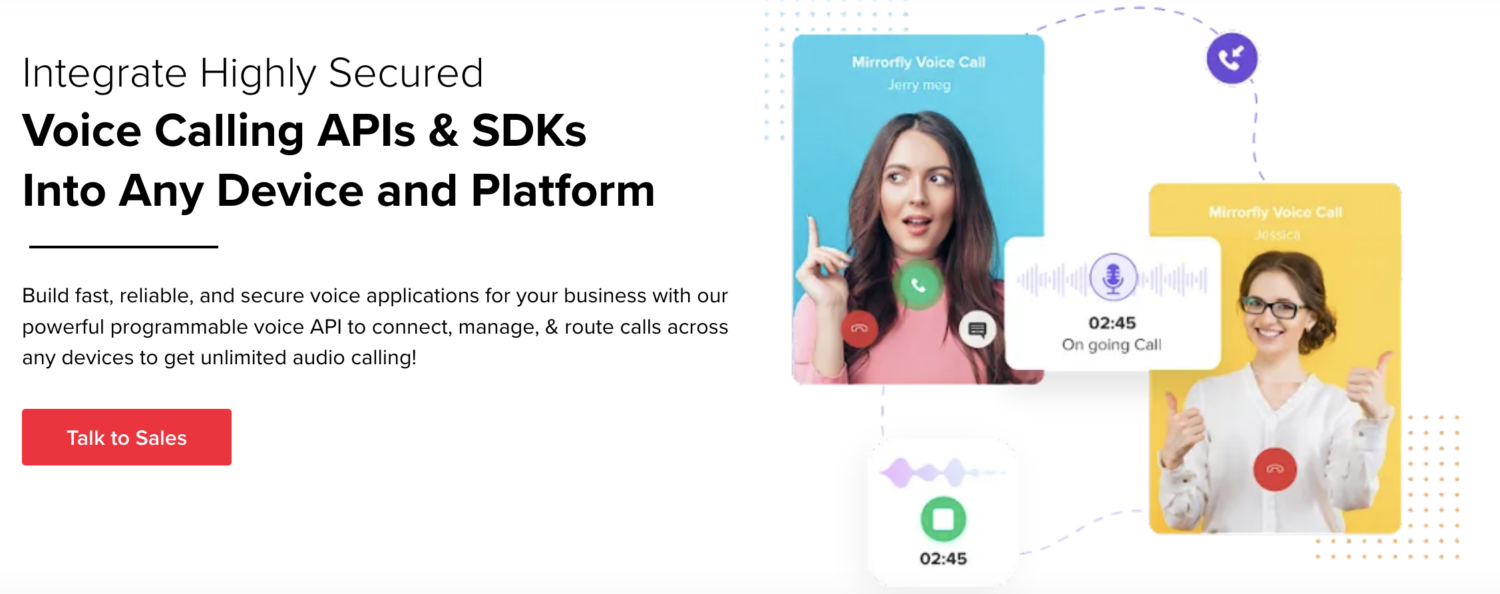
Here are some of its features:
- Encrypted Audio
- Low Latency
- Natural Language Processing
- Audio re-routing
- Virtual Number Allocation
Using its low-latency voice API, up to 250 participants across the globe can participate in discussions, meetings, and webinars with clear voice quality.
ZegoCloud
ZegoCloud provides real-time interaction services for cloud communication and aims to revolutionize virtual engagement with real-time interaction. It aims to connect enterprises, teams, customers, and users.
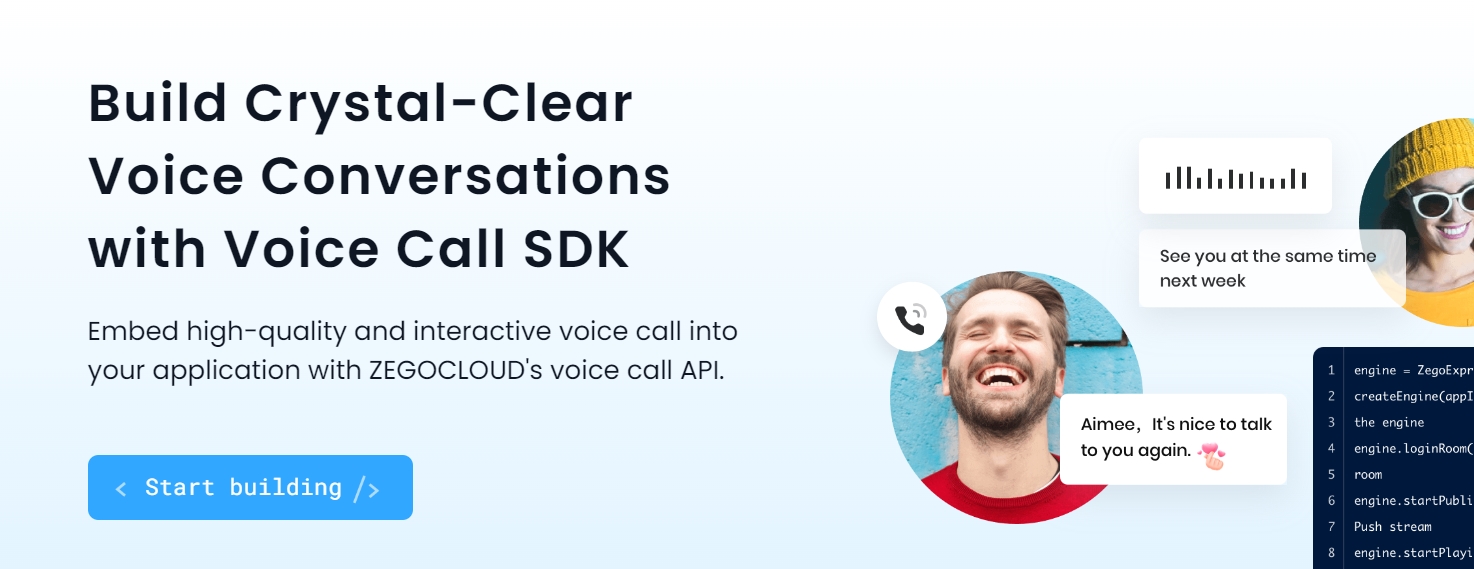
UI kits and SDKs are the two different ways to implement Zegocloud’s voice-calling APIs. If you want to integrate voice calling features into your application without caring much about UI, then you can go for the UI kits. Otherwise, Zegocloud also provides low-level SDKs for voice API integration. As far as the pricing is concerned, Zegocloud follows a similar pay-as-you-go concept.
Bandwidth
Bandwidth provides cloud-ready voice, messaging, and emergency service connectivity built for the enterprise.
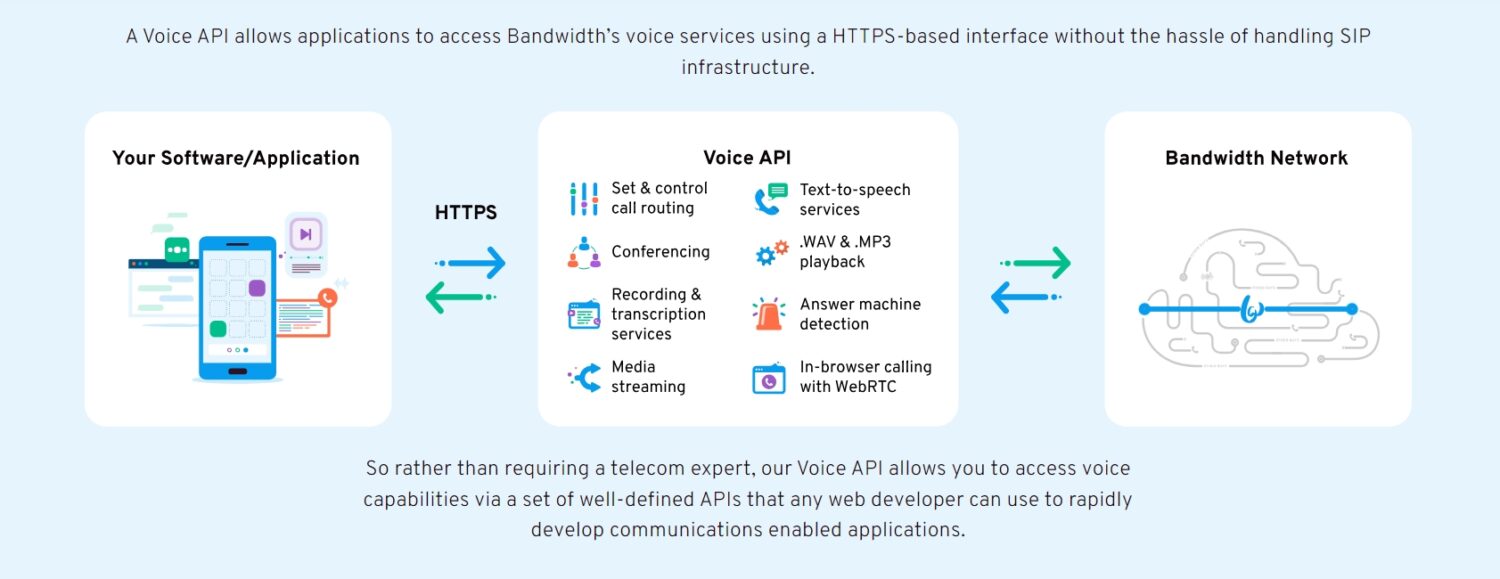
Several features of the voice API are mentioned below:
- Call Control
- Real-Time Transcription
- Answering Machine Detection
- Conferencing
- Media Streaming
Building a custom voice calling solution that’s good for customers without building your own telecom infrastructure and embedding inbound and outbound calling capabilities directly into your application is what Bandwidth’s voice API tries to achieve.
Sinch
Sinch is a cloud customer communications platform that lets you integrate messaging, voice, or email capabilities into the application and lets you have meaningful conversations with improved scalability, deliverability, and cost-effectiveness.
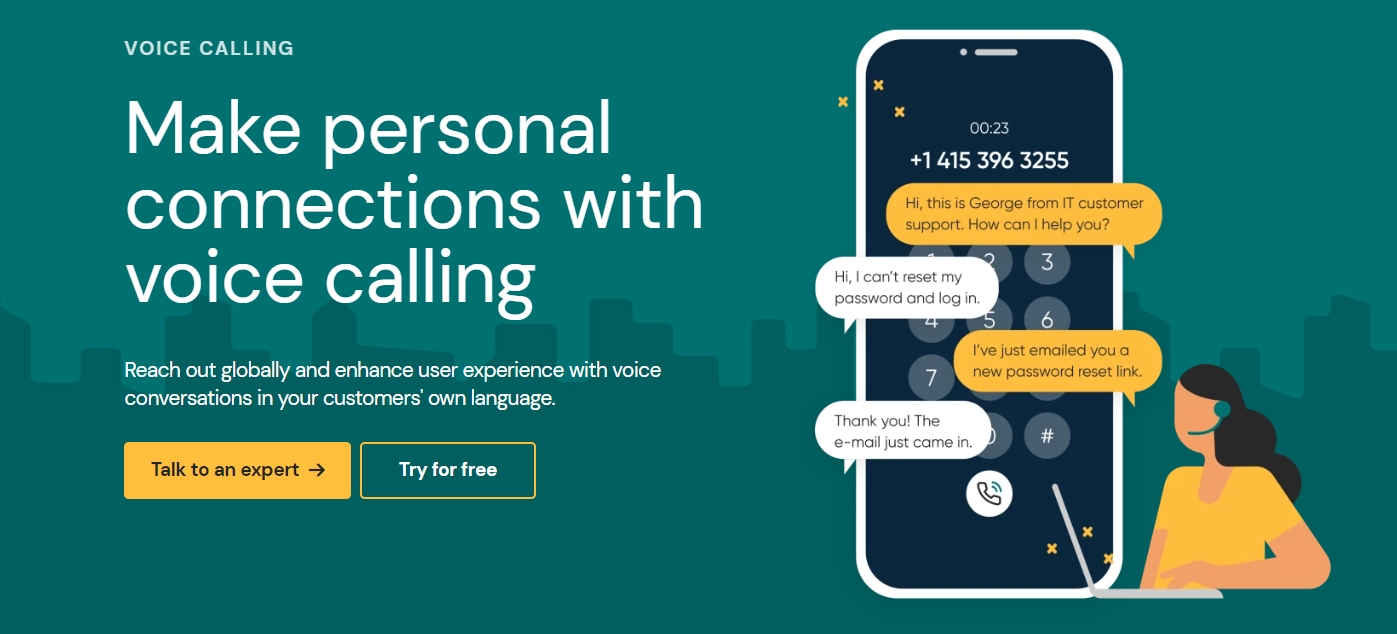
Its more of a customer engagement improvement tool; however, the features provided by its voice API are:
- Number masking
- Phone call verification
- Secure Telephone Identity Revisited (STIR)
- Recorded Prompts
- Voice-based IVR
At the time of writing, there’s no pricing information available, so you need to contact sales for that.
Infobip
Infobip is a global communications platform that provides a number of APIs and technologies that let companies interact with their clients through SMS, voice, email, chat apps, and other communication channels.

Common features are mentioned below:
- SIP trunking
- WebRTC
- Number masking
- IVR
Its voice API lets businesses connect with their customers with features such as automated voice calls, pre-recorded audio files with over 100 supported languages, recorded calls, efficient call routing, detailed call reporting, and much more.
Final Words
Choosing a voice API isn’t based on what cool features a platform offer. It solely depends on your business requirements and what you want to achieve from the API. However, you should pick a voice API, keeping security and reliability in mind. By comparing various voice APIs, you can conclude that they are more suitable to your needs.
If you want to explore customer engagement tools, here are some open source live chat software to look out for.

